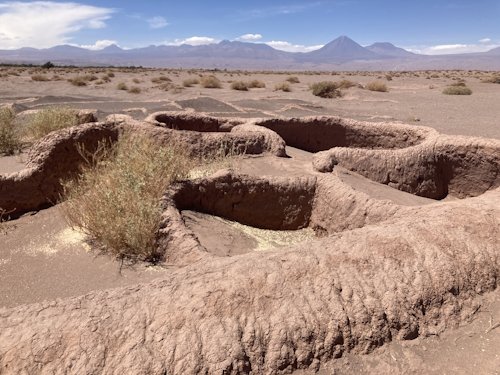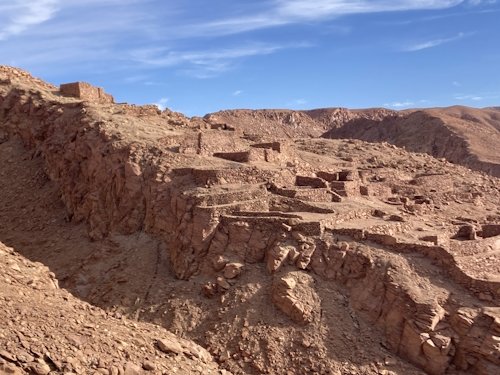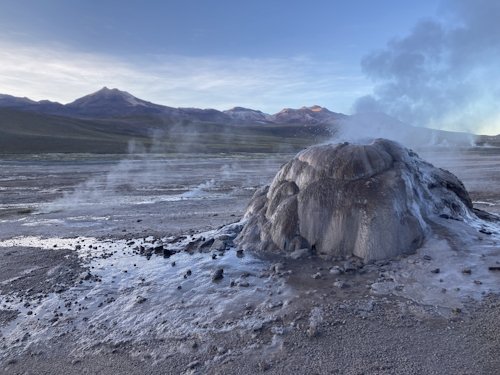Els Slots
San Pedro de Atacama
The Tentative Site description for San Pedro de Atacama tries to paint a picture of the history of the region from 10,000 BC til the 18th century AD. The focus of a future WHS may however lay in its Pre-Columbian sites, maybe even narrowed down to the Pre-Incan sites, as the Incan site of Catarpe is already part of the Qhapaq Nan WHS. The people who lived in this high desert region settled down to breed llamas and cultivate maize. They were also part of a wider trade route.

The main archaeological site of the area is Tulor, known in Spanish as Aldea de Tulor (meaning: Village of Tulor). I went there on a bicycle, which is easy to rent in the center of San Pedro. It’s a ride of 11km and the terrain is mostly flat, however at a temperature of 32 degrees Celsius and scorching sun it is exhausting. I stopped twice along the way (at a bus stop and a truck weighing station) to get some shade and drink water. When I finally arrived at the archaeological site, I found a cute bike parking but the entrance to the site was closed. Fortunately, a woman came out and told me they were having a lunch break so I needn’t wait long.
The entrance fee is 5.000 pesos and can be paid by card. From the reception area, it then is another 600-meter walk in the heat through the sand to reach the remains. I can fully understand why the ancient Atacameños abandoned this site! When they settled it, there was water from the San Pedro River. Now there is none and the sand dunes have encroached. The people lived in circular mud huts that were connected via small passageways (photo 1). It’s a small site but it's a wonder that it has been preserved at all given its age and setting. The World Monuments Fund has put money into it twice, but the site was afterward vandalized in 2010 (of which I saw no trace anymore in 2024). All archeological sites and nature reserves in the San Pedro de Atacama region are now managed by the indigenous communities.

Another interesting site is the Pukará de Quitor (photo 2). Now this is a very ‘late’ fortress, established around 1300 which is some 1,000 years after Tulor was abandoned. It saw the Incas arriving around 1450 and the Spaniards conquering it in 1540. It lies a 3km walk from the center of San Pedro, following the dry river bed of the San Pedro River. The entrance fee here is 5,750 pesos (6 EUR), rather steep given the fact that you may not enter the archeological site itself and have to haul yourself up on foot to viewpoints on the hill next to it.
What this site offers though is a few good information panels that split the Atacameño history into 4 phases: (1) the hunter-gatherers, (2) the period of settlement as exemplified by Tulor, (3) a stage from 400-1000 CE where the area was in the sphere of influence of Tiwanaku but which has not resulted in visible remains, and (4) a period of intensified exploitation of the lands. The Pukará de Quitor was used in stage 4 as an administrative center and as a retreat in case of attacks. Again, this is a small site with groups of stone buildings built against a volcanic rock. Both Tulor and Quitor in my opinion have regional value only (hence my ‘thumbs down’ rating). They provide a reasonably interesting view into how people lived outside of the big Pre-Columbian empires, but there will be many of those in the Americas and the Atacameños didn’t leave any traces as remarkable as the Chinchorros did for example with their mummification techniques.

The town of San Pedro de Atacama itself is "tourist central", and it is remarkable how many foreign tourists manage to reach it. Even in mid-March, the daily temperatures rose to 32 degrees Celsius and the sun is unforgiving. From here it is easy to access the natural wonders in its hinterland with a rental car or by day tour. We entered the Atacama Desert on our Missing List , and seeing the geothermal field of El Tatio (photo 3) in the early morning or the Valle de Luna shaped by sandy salt is indeed magic and worth a journey.
More on
Els SlotsComments
No comments yet.
